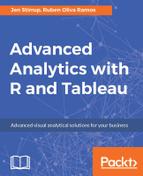In this chapter, we will look at ways to perform classification using R and visualizing the results in Tableau. Classification is one of the most important tasks in analytics today. By the end of this chapter, you'll build a decision tree, while retaining a focus on a business-oriented understanding of the business question using classification algorithms.
When we are modeling data, it is crucial to keep the original business objectives in mind. These business objectives will direct the subsequent work in the data understanding, preparation and modeling steps, and the final evaluation and selection (after revisiting earlier steps if necessary) of a classification model or models.
At later stages, this will help to streamline the project because we will be able to keep the model's performance in line with the original requirement, while retaining a focus on ensuring a return on investment from the project.
The main business objective is to identify individuals who are higher earners, so that they can be targeted by a marketing campaign. For this purpose, we will investigate the data mining of demographic data in order to create a classification model in R. The model will be able to accurately determine whether individuals earn a salary that is above or below $50K per annum. The datasets used in this chapter were taken from the University of California Irvine Data repository, which you can find at the following URL: https://archive.ics.uci.edu/ml/index.html. The dataset used is known as the Adult dataset, and it holds information on individuals such as age, level of education, sex, and current employment type.
The resulting model will be used to classify individuals for the marketing campaign. To do that, we must understand the predictive significance of each characteristic.
